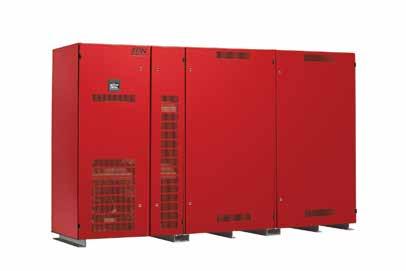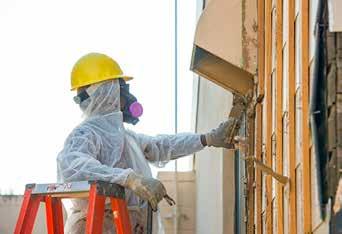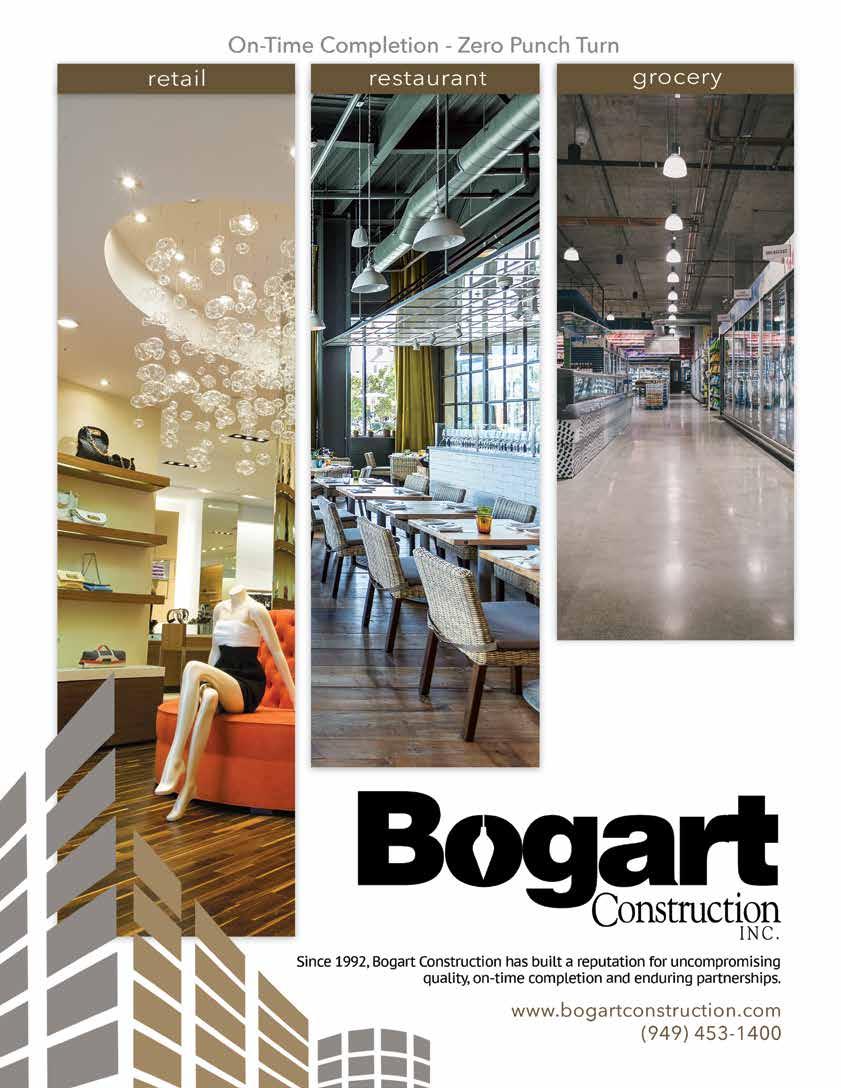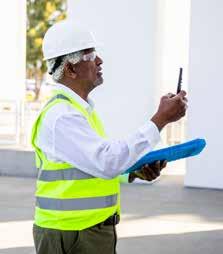
23 minute read
Industry News
from CCR OCT 20
RETAIL
MAC
Beauty retailer MAC has opened the MAC Innovation Lab, its newest concept store, at the Queens Center mall in New York City after testing a virtual version of the concept in Shanghai in 2019. The store features augmented reality mirrors for shoppers to try products without touching their faces, infrared touch screens for finding just the right foundation match and special packaging that buyers can customize.
REI
REI has kept a promise made in 2006 to become carbon neutral by this year via receiving green building certifications, generating solar energy and funding $100 million in outdoor spaces. Now the outdoor gear retailer is focused on a new goal of cutting its carbon footprint in half by 2030 to fight climate change.
Walmart Health
Walmart disclosed plans to open “Walmart Health” centers in the Tampa and Orlando, Florida markets, and additional locations in Georgia that feature an array of primary medical services, dental care and behavioral health services. The new model is being replicated across the country.
Hy-Vee/DSW
Two Hy-Vee locations in Minneapolis now are home to 1,200-square-foot shoe stores operated by DSW, with the mini-stores aimed at reaching potential footwear customers where they shop for food. There could be as many as six similar arrangements at Hy-Vee sites coming, with plans for a wider rollout of the concept in 2021.
IKEA
IKEA will open 50 new stores around the world this year, as it continues to bet on brick-and-mortar retail, despite the rise of e-commerce.
Tiffany & Co.
Luxury jeweler Tiffany & Co. will open a new 5,400-square-foot store at the Westfield Valley Fair mall in San Jose, California. The two-story store replaces a smaller Tiffany’s location there.
Suitsupply
Suitsupply has added two floors and a rooftop space to its store in New York City’s SoHo neighborhood, creating space for private affairs and individual shopping appointments. The retailer is betting that customers have a pent-up demand for shopping as they did in pre-pandemic times. HOSPITALITY
Waldorf Astoria
Waldorf Astoria Monarch Beach Resort & Club will bring Hilton’s luxury brand to Dana Point, California. The 400-room property, which features an 18-hole golf course, partners Waldorf Astoria Hotels & Resorts with Ohana Real Estate Investors.
Hilton Worldwide
Hilton Worldwide has 781 hotels comprising 160,556 rooms in its pipeline, with 200 openings slated for this year. North America and the Asian-Pacific region command top priority, led by the US and China.
InterContinental Hotels Group/Voco
InterContinental Hotels Group will unveil its new lifestyle Voco brand in Florida, Missouri and New York. Plans call for opening 28 hotels in 19 countries over the coming five years.
Capella Hotels and Resorts
Capella Hotels and Resorts opened its first property— Capella Bangkok—in Thailand. The 101-room property, which overlooks the Chao Phraya River, includes a spa, open-air dining and a restaurant from Italian-Argentine chef Mauro Colagreco.
Kalahari Resorts
Kalahari Resorts and Conventions plans a new location in Round Rock, Texas. The 350-acre resort complex will include a 223,000-square-foot water park, 30 water slides, 20 whirlpools and pools, and other attractions such as a FlowRider, waterfalls, cabanas and an adult grotto swim-up bar.
Atari Hotels
Video-game giant Atari plans to open a line of hotels, beginning in Las Vegas and Phoenix, with an emphasis on virtual reality and cutting-edge design. The 400-room Atari Hotel near the Las Vegas Strip is scheduled to open in 2022.
RESTAURANTS
Burger King
Burger King is focusing on mobile and touchless services with two new restaurant designs to be introduced next year. A drive-in feature will allow customers to park under solar-powered canopies and place their orders to eat in their cars, while a curbside feature will allow for quick pickup of previously placed orders.
Cracker Barrel
Cracker Barrel is experimenting with several new revenue channels, including grab-and-go takeout stations, separate catering kitchens and the conversions of its signature porches into open-air seating areas.
Taco Bell
The first on-campus Taco Bell Cantina opened at the University of Texas at Dallas this semester. Franchisee North Texas Bells is operating the restaurant in conjunction with foodservice provider Chartwells Higher Education and UT Dallas.
Slim Chickens
Arkansas-based Slim Chickens will expand into Maryland, New Jersey and Washington in 2021. The 96-unit fast-casual chain, which rolled out a smaller footprint last year and began moving into nontraditional venues, is moving forward with plans to grow to 600 locations over the next 10 years.
The Melting Pot
The Melting Pot is creating Melting Pot Social, a concept that will meld features of fast-casual and full-service dining.
Trader Joe’s
Trader Joe’s is continuing its expansion in New Jersey with a 12,500-square-foot store in Freehold. The grocer, which also recently added a site in California and has stores on the way in Florida, Virginia, Indiana and Arizona, is planning to replace its store in Wayne, New Jersey with a larger location and add a new 14,000-square-foot store in Bayonne.
Amazon Fresh
Two locations across the country from each other—near Seattle and outside Washington, DC—could be among the latest sites for Amazon Fresh brick-and-mortar grocery stores.
Jet Foods
The Chicago-area towns of Carol Stream, Park Forest and Des Plaines are getting new grocers, as Jet Foods begins making an aggressive push into the area with a plan to offer discount prices and prepared meals for customer convenience.
Wegmans
Wegmans has added a second North Carolina in Raleigh’s West Cary neighborhood, with plans to debut at least four more locations in the state. The grocer will open new stores in Wake Forest and Chapel Hill in spring 2021. It also confirmed its intention to open more sites in Cary and Holly Springs in the near future.
ALDI
ALDI’s new store in Philadelphia will occupy the base of a 475-unit apartment complex and, at 25,000 square feet, will be about 50% larger than most of the grocer’s older locations. The new market is set for a November opening and plans call for six aisles and a fresh food section that is 40% bigger than other ALDI sites.
Southeastern Grocers/Fresco y Mas
Southeastern Grocers is following through on its plan to invest more in its Fresco y Mas banner, with plans to open the 27th store near Fort Myers, Florida. The grocer also is converting a current Winn-Dixie site into the Hispanic-themed banner.
Pollo Campero
California-based chicken chain Pollo Campero plans to open 250 new US units over the next five years, with a focus on five states in the Southeast. The chain grew sales during the pandemic using a digital platform that it rebuilt last year, and by putting efforts into curbside pickup, drive-thru and delivery.
The numbers game 19
The percentage increase, on a national average, that construction workers ($47,430) earn more than the median wage for all workers ($39,810) annually, according to a new report by Construction Coverage.
60
The percent of commercial construction contractors who said they had to delay or cancel at least one planned project since the pandemic hit, according to a survey by Associated General Contractors (AGC) and Autodesk. Substantial numbers also cited lengthier project times and rising costs due to the pandemic.
400
The funding, in millions, that transit infrastructure projects advancing in Arizona, Indiana, Missouri and New Jersey will get from the US Department of Transportation’s Federal Transit Administration. The funds come under the Capital Investment Grants program, which requires that projects undergo a multiyear, multistep process.
INDUSTRY NEWS NEWS, NOTES & TRENDS... With the advent of the COVID-19 pandemic, it is no secret that disinfectant rag. In addition, thanks to their customizability of fabrication, solid surface Safety first 3 hygienic building materials for your commercial space hygiene and sanitation are at the forefront of materials can be used on your backsplash public consciousness. Therefore, if you are and walls to give them the same hygienic designing or remodeling a commercial space, properties, if so desired. consider some of the following hygienic building materials to streamline your sanitation efforts.
Commercial spaces are sure to feature a wide variety of counters, tables and bar surfaces upon which traffic will congregate. Cracked or otherwise porous surfaces are not only a threat for unsightly stains, but offer a haven in which harmful germs and bacteria can nest. Choosing one-piece, acrylic-based solid surface materials will give your surfaces a durable, nonporous finish that will repel harmful substances and make cleaning as simple as a run of the
Stainless Steel Fixtures One of the primary measures recommended by the CDC for keeping an area sanitized is to regularly clean frequentlytouched surfaces such as doorknobs and sink handles. Therefore, when choosing materials for these locations, it is vital you select a product that will not lose its luster in the face of frequent cleaning. Stainless steel makes for a great selection, as it is durable, non-staining and complements many industrial designs, such as exposed lavatory pipes and hospital handrail options. Solid Surface Countertops
Polished Concrete Floors When designing a hygienic floor for a commercial space, it is important to take every measure to eliminate seams, as bacteria loves to nest in grout and sealers, which can be difficult to reach and clean. As such, the solid, sealed, one-piece design of polished concrete offers a durable flooring option that will withstand heavy traffic while resisting staining that can lead to bacteria buildup.
Matt Lee is owner of the Innovative Building Materials blog and a content writer for the building materials industry. He is focused on helping fellow homeowners, contractors, and architects discover materials and methods of construction that save money, improve energy efficiency and increase property value.
They said it
“For all of us, we are passionate about building a better future for ourselves and our friends. We’re going into the local communities and resourcing our teams from there. We set up a pop-up school in each location, and we take them through a training program and employ them, because at the end of the day, we want to be welcomed into somebody’s home and somebody who’s local. So we’ve now made a commitment that every single project we have is going to be the foundation for creating sustainable, viable economies.” — Oliver Ripley, CEO of Habitas, on the company’s new 3D hotel projects it is building in Namibia and Tulum, Mexico
“People have left the cities where we don’t have stores. They’re moving into suburbs [or] they’re moving out of the suburbs. So they’re moving out to the rural communities.” — Harry Lawton, CEO of Tractor Supply, on what’s driving the retailers continued growth
“There’s just nothing out there that says you can’t make smart investments outside of your core businesses.” — Simon Property CEO David Simon on the multi-pronged approach in which it is working to rescue certain financially distressed retailers, while also engaging in talks to house Amazon distribution centers in its malls
Did you know
Mandates enforcing social distancing, mask-wearing and reduced capacity may be affecting the appeal of shopping malls, but experts say consumers eventually will return to their social instincts and see the value of having many retailers in one location. According to CoStar Advisory Services, one trend will be the adoption of virtual shopping apps for consumers still cautious about public spaces, as well as the repurposing of malls as “lifestyle spaces,” with a mix of retail, restaurants and office space.
Dine and tap…

Technology will save us. According to Technomic, customers say they will still feel welcome amid the pandemic if a welcoming experience is provided. In fact, 46% say they want to be able to order online or at a kiosk or tabletop when in a restaurant, while 43% want to pay that way, too. Not the hippest, coolest, sleekest tech, just something easy like QR codes.
EONTM MODEL EL3 Three Phase Centralized Emergency Lighting Inverter Now Available Up To 55 kW!


LED Fixture / Driver Compatibility
High peak overload capability of 1700% to accommodate inrush current from LED fixtures / drivers while fed from the AC power source, or even while in battery mode.
Full Compliance With NFPA 101
Computer-based, self-testing / self-diagnostic emergency lighting system with data-logging and remote communications via BACnet, MODBUS, and Ethernet.
Compact, Space-Saving Footprint
Physically smaller than comparable three-phase emergency lighting inverter products, without compromising performance or serviceability.
10 kW – 55 kW Download a brochure and specifications today!
UL 924 Listed — Emergency Lighting Equipment C-UL Listed to CSA C22.2 No. 141-10; 141-15
www.controlledpwr.com/EON_1
INDUSTRY NEWS NEWS, NOTES & TRENDS... All hands on deck 5 reasons to bring construction management experts into litigation planning From mediation through trial, to assisting in demonstrating the facts of the case, expert witnesses commonly are part of construction litigation proceedings. But often there is hesitancy to bring an expert into the process earlier on, either due to the economics involved or to not being aware of issues that will have a bigger influence on the outcome/resolution. But incorporating their deeper analysis as a component of litigation planning can help to achieve more successful results. Jeffrey B. Kozek, J.D., CFCC, a founding member and Principal of Resolution Management Consultants (RMC), shares five ways construction consultants’ industry expertise can benefit a construction case:

No. 1 — Prior case experience & expertise After years of working on after-the-fact claim scenarios as well as working with clients during the job on an ongoing basis, consultants have accumulated diverse experience with the factors that lead to or escalate disputes and delays. Their knowledge and experience help sort and slice through a voluminous set of records to identify a clearer path to the root cause of an issue. No. 2 — Thorough analysis Technical elements of cases may not be initially understood by all participants in legal-proceedings, including some of the decision-makers. Not only do experts provide detailed analysis, but their experience can help bring everyone to the same degree of understanding about the project or conflict.
No. 3 — Scope of the case Construction case records span all areas of a project, meaning there can be much more data produced than necessary to make a determination. Consultants’ expertise helps strip away extraneous details and focus proceedings on a lynchpin element of the dispute. If conflicts ultimately go to trial, experts can help narrow the issues to appropriate focal areas.
No. 4 — Deeper insights When both sides of a conflict have more information, particularly from third parties, they may begin to assess the case differently. In understanding the reality of their situation, many people realize their position is not as strong as they were led to believe and will be more willing to resolve the dispute rather than risk the time, cost and aggravation of proceeding with the litigation.
No. 5 — Reduce litigation risk After resolving construction litigation, clients’ hindsight often serves as a reminder to make better preparations for the next project, i.e., lessons learned. Consultants’ expertise can help project participants identify potential risks prior to construction that can aid in avoiding issues altogether, minimizing them from happening and/or placing the client in a better position with their documentation if a dispute arises that cannot be amicably resolved during the job.
2020 Annual Facility Maintenance Listings
SMG Holdings LLC
Tom Kay, Chief Revenue Officer 2517 Highway 35, Building L Manasquan, NJ 08736 (732) 223-5000
www.smgholdingsllc.com • tomkay@smgholdingsllc.com
Year Established: 1996, No. of Employees: 36 Services Provided: Electrical, Floorcare, HVAC, Janitorial, Landscaping, Consulting, Lighting/Re-lamping, Painting, Windows, Parking Lot, Pest Control, Plumbing, Roofing, Sinage, Equipment, Waste Disposal, Snow Removal, Mold Remediation, Emergency/Disaster Response Specialize In: Big-Box, Specialty Stores, Groceries, Shopping Centers, Drug Stores, Hotels, Restaurants, Education, Healthcare, Federal, Senior Housing Leading Clients: Advance Auto, CVS, Walmart, Navy Federal, Office Depot, Sephora, Sleep Number, Restoration Hardware
GGS Partners, LLC
Neil A Sperling, Managing Partner P.O. Box 3075 Margate,NJ 08402 (609) 313-4346 • Fax: (856) 424-5386
www.ggspartners.com neils@ggspartners.com
Year Established: 2003, No. of Employees: 5 Services Provided: Electrical, Floorcare, HVAC, Janitorial, Lighting/ Re-lamping, Painting, Windows, Pest Control, Plumbing, Locks, Handyman Specialize In: Specialty Stores, Restaurants, Healthcare, Multi-Site Franchises Leading Clients: N/A
INDUSTRY NEWS PERSPECTIVE Battening down the hatches Four lessons learned on completing small- and mid-sized projects in uncertain times By Joshua Zinder & Mark A. Sullivan
Adjusting to the new normal has created ripple effects for construction teams beyond social distancing and face masks. With projects ongoing from before the start of stayat-home and lockdown orders, today’s construction companies are seeing timelines expand, sequencing changes, developer unease—and even outright defiance—as the evolving crisis has revealed the places where the rubber meets the road, so to speak.
As construction is set to “re-open” statewide in places like New Jersey, project stakeholders need to apply sensible strategies for keeping contractors and subtrade teams healthy, safe and productive. And as the medical community warns of a “second wave” for the pandemic later this year, it is important for architects and GCs to be ready to adjust to possible lockdown orders down the road. The following lessons from our recent experience on completing (or not) ongoing projects are presented as a guide for project teams going forward during times of uncertainty.

Lesson 1: Safety is a team effort Compliance normally falls within the domain of the contractor, but these are times of heightened risk, in which public health is a collective responsibility. If a worker on site is not wearing his mask, the danger in looking the other way is not that worker’s alone—he could put other workers at risk, and their families. And as the weather gets warmer and masks become increasingly uncomfortable to wear while working, enforcing safety measures becomes mission critical. Large companies typically do this already because they have the resources. Smaller firms must consider how to monitor their crews as well as subtrades, strategically and cost-effectively, to enforce safety requirements. In the industry’s earlier times, there were strictly enforced safety protocols for many construction projects, including regular inspections by a safety superintendent. The level of policing needed to address both construction safety and public health concerns needs to rise to the occasion, and construction companies themselves will shoulder most of the responsibility. They are already expected to submit COVID plans, and enforce them.
Lesson 2: Everything will take longer, so plan accordingly Social distancing and state orders for essential construction work caused timelines to swell from days to weeks, or even months, as we learned from the lockdown order’s impact on a 10-unit multifamily adaptive reuse project. Trades have to work in alternating shifts rather than simultaneously, with exceptions for exterior crews that have more opportunities for social distance.


INDUSTRY NEWS PERSPECTIVE Under normal circumstances, a site visit by the building inspector (or the client) will result in approvals for several advancements, but these days there usually is just one component completed at a time. The result is an increased number of site visits, sometimes twice or three times as many as in the past. While frustrating, there was no way around it. Project teams that accept the cold hard facts of the new normal can try to find drywall installation above while plumbing or electric gets installed below. Construction pros may land on innovations in scheduling and phasing that could be of value to non-lockdown projects in the future. Lesson 4: Communication is more important than ever The state lockdown order in New Jersey Project teams ways to innovate to reduce the timetables more than just marginally. Another silver that accept the came down at an inopportune time for the renovation of a three-story, mid-19th-Cenlining is that additional site visits ensure construction is proceeding safely for your cold hard facts of tury mixed-use building on Princeton’s main retail corridor. The project was in the teams on the ground. the new normal middle of demolition, which had revealed serious issues. The roof of the stick-built
Lesson 3: Trade teams need to work individually can try to find semi-timber structure was in need of critical attention, possibly even in danger Clients and project teams have had to adjust to trades working on a rotating schedule in ways to innovate of collapse, and an existing steel beam on the first floor needed reinforcement. order to enforce social distancing. This is an inconvenient reality and the main culprit for to reduce the There was no way we could stop work and walk away, especially since the lagging timelines. Construction administrators should try to create optimized schedules timetables roof condition was a threat to adjacent buildings with residents under stay-atby staggering chunks of time throughout the day for trade teams to come in and out. more than just home orders inside. To make it happen, the construction Another possibility is to divide trade assignments by floor, which might allow marginally. team had to step up communications efforts across the project team, and especially with legal representation and government agencies overseeing both construction safety and public health. Some days seemed to be spent entirely on the phone or in virtual meetings. By staying in close contact with all stakeholders, they were able to arrange a suitable solution on a viable timetable. More than ever, teams must communicate efficiently and swiftly. Construction teams should be proactive in how they adjust to the new normal, enforcing heightened safety measures around mask use, adjusting schedules to enable as much social distancing possible between workers and keeping the communication lines more open than ever with their clients and designers. This way, whether there is a second wave or not, the construction industry can work its way toward thriving once more and be better off in the future for the lessons learned in such unprecedented times. CCR

Joshua Zinder, AIA, managing partner, and Mark A. Sullivan, AIA, partner, work for JZA+D (joshuazinder.com), a Princeton, New Jersey practice functioning as a multidisciplinary team that shares sustainable and contemporary design aesthetics and aspirations. The JZA+D team has won numerous design awards and its work has been seen in publications around the world.
INDUSTRY NEWS PERSPECTIVE On-Site to online COVID-19’s transformational impact on construction and development By Chris Guderian

COVID-19 unilaterally has impacted operations across all industries, but effectively has upended business protocols and procedures in sectors like construction. In a profession that historically has relied heavily on handshakes and on-site meetings, developers and project managers now are faced with the unique challenge of overseeing complex projects, and a network of contractors and subcontractors without face-to-face communication.
Generally, the construction industry has lagged in terms of technology adoption. Companies ahead of the curve that invested early on in construction tech may have put solutions or software in place, but these often were leveraged on a small scale or used in conjunction with long-established, albeit dated, industry best practices. Old-school construction professionals who have built their careers on pencil and paper as well as on-site job updates have shied away from technology. This has proven to be a barrier to adoption even in companies that recognize the benefits to productivity and efficiency. But COVID-19 has rendered these old-school business practices obsolete and, in many ways, unsafe. Restrictions implemented on in-person gatherings could have brought the industry to a grinding halt but, fortunately, technology has empowered project managers to replace in-person tasks with virtual collaboration tools to streamline operations, and keep contractors and subcontractors informed, upto-date, and most importantly, safe. A paradigm shift that many experts predicted would take years to accomplish seemingly has happened overnight as COVID-19 and social distancing mandates forced rapid, industry-wide technology adoption to keep projects on track.

INDUSTRY NEWS PERSPECTIVE Streamlining projects Cloud-based platforms not only enable project managers to keep contractors and subcontractors up to date, they also streamline every phase of a job from start to finish while limiting the number of people on-site. Tools with videoconferencing and screensharing capabilities also quickly have become necessities for internal and external meetings. jobs virtually, providing contractors and subcontractors with an immersive touring experience without needing to travel to the job site. This process also reduces the amount of time needed on-site, enabling project managers to capture the same information that an on-site walkthrough would by taking multiple photos that can be studied off-site and instantly shared with collaborators. Regardless of where sites are located, virtual walkthroughs Weekly video calls have replaced regular on-site meetings and, as enable teams to tour multiple sites in the same day without a result, contractors and subcontractors are more informed than ever. needing to leave the comfort of their homes or offices. It also Technological platforms enable construction gives higher level executives the freedom and development teams to review site plans, to check in on a project firsthand without drawings and documents, as well as daily needing to physically be at the site, saving time-stamped progress photos, all but elimi- valuable time and resources. nating the need for multi-person site visits. Real-time updates also decrease the Looking to the future chances of a team member reviewing the While the timeline for technology adopwrong plans while ensuring everyone—not tion in the construction industry has been just the general contractor—has access to significantly compressed out of necessity the resources and data they need at all times. due to COVID-19, the myriad advantages Further enhancing efficiency, some ser- it presents will ensure these solutions are vices also can streamline billing processes here to stay. The increases in efficiency, allowing for the direct receipt and payment cost savings and flexibility brought on by of invoices. With skeleton crews handling construction technology are just too hard physical office operations due to social to ignore. distancing guidelines, digital invoicing allows Further, technology now has the power for faster and more seamless payments. to further differentiate firms in the construcWith their digital footprint, these tools tion industry—those who embrace these also can provide an instant look at a job’s hard costs, offering development compa- A paradigm shift tools will not only be more efficient, but also can overcome geographical barriers and nies with a better understand of a project’s financials and providing the data needed for that many experts expand into new markets. As digital proficiency begins to play agile decision-making. predicted would take a more prominent role in the industry,
Virtual site tours years to accomplish project managers will need to weigh use of technology platforms more heavily In addition to virtual job plans and punch lists enabling contractors and subcontrac- seemingly has than before, and those contractors and subcontractors who fail to adapt ultimately tors to see exactly what is happening on job happened overnight will be left behind. As the sector gets a sites at any time, advanced solutions take the experience one step further and allow for as COVID-19 and taste of how much can be accomplished without even touching a job site, project the integration of virtual site tours. Instead of gathering the key players social distancing managers undoubtedly are reconsidering how they score prospective contractors on-site for a walkthrough, which entails mandates forced moving forward. coordinating several conflicting schedules and factoring in varying commute times, rapid, industry-wide While COVID-19 has been—and continues to be—a tremendous physical, all project managers now need to give everyone a firsthand look at the progress of technology adoption emotional and economic burden, one small benefit of the pandemic is its transformaa site is a camera and a hardhat. to keep projects tion of the construction industry, which in Smartphone cameras or 360-degree hardhat cameras allow companies to walk on track. mere months, has been forever changed for the better. CCR

Christopher Guderian serves as Director of Construction for Denholtz Properties, a privately held, fully integrated real estate development and investment company based in Red Bank, New Jersey. To learn more about Denholtz Properties, visit Denholtz.com or message Christopher on LinkedIn.









